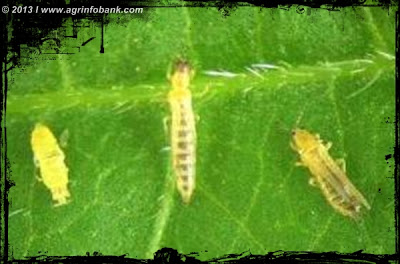Agriculture
 It is grown in Maharashtra, Gujarat, Rajasthan, Orissa, Madhya Pradesh, Utter Pradesh, Punjab, Haryana and Tamil Nadu (Nilgiris and Kodaikanal hills).
It is grown in Maharashtra, Gujarat, Rajasthan, Orissa, Madhya Pradesh, Utter Pradesh, Punjab, Haryana and Tamil Nadu (Nilgiris and Kodaikanal hills).
 A single female lays 40-50 eggs which hatch after 4-9 days. The entire life cycle is completed in 11-21 days. There are more than ten generations per year. The pest occurs on garlic from November to May and migrates to other crops from June.
A single female lays 40-50 eggs which hatch after 4-9 days. The entire life cycle is completed in 11-21 days. There are more than ten generations per year. The pest occurs on garlic from November to May and migrates to other crops from June.

Mr.Jayaraj (Author)Source of Article: 

- Insect Pest Of Rice: Rice Leaf Folder Or Rice Leaf Roller
1. larva in action 2. adult rice leaf roller motha leaf rollRice leaf folder or roller is considered one of the major harmful insect pest of rice. It is common in maximum rice growing are. It?s scientific name is Cnaphalocrosis medinalis...
- Top 5 Pests Of Tomato
The following pests are considered the most common. Pictures of each of them are available on the web and can be obtained by doing a web search using the name of the pest. Additional tomato pests not covered here include cutworms, flea beetles, grasshoppers,...
- Pest Threat To Sindh`s Cotton Crop
Author: Mohammad Hussain Khan As cotton farmers in Sindh begin crop picking, they have a reason to worry: pests like mealybug, thrips and pink bollworm have started attacking patches of their farmland. In lower Sindh, where cotton is sown early, picking...
- Top 10 Insect Pests Of Cotton In Pakistan
Insects represent a widely studied group of arthropods having diversity in their habitat and life forms. Adaptation of insects may be directly correlated with the successful evolution history. Scientists are working day and night to find the successful...
- Mealybug Destroyer
Mealybug DestroyerFirst used as a biological control agent in the late 1800's, both the adult and larval stages of this beneficial insect attack and feed on all stages of mealybugs. The mealybug destroyer (Cryptolaemus montrouzieri) is a small (1/5...
Agriculture
Management of Thrips in Garlic
Garlic is widely used as a condiment in Indian cuisine, especially for its medicinal properties.

Among the insect pests, the onion thrips, Thrips tabaci is a major one injuring garlic.
Damage symptoms
Both nymphs and adults cause injury to the plants by sucking the vital leaf sap.
They remain in dense concentrations at leaf bases and whorls and feed by lacerating the tissues and imbibing the oozing cell sap.
The infestation develops a spotted appearance on the leaves, subsequently turning into silvery white blotches. The leaf tips fade and the basal portions get blighted and distorted from tip downwards and finally the plant dries up. The affected plants yield less, with small sized bulbs.
Adults are slender, yellowish brown and measure about 1mm in length and have narrow fringed wings.
Eggs are laid singly in tender leaves by making slits with sharp ovipositors by the females.

Management
Varieties with open type growth and circular leaf structure are not preferred by thrips.
Tolerant varieties of Garlic viz. G-2, G-19, LCG-1, Ooty-1 may be utilised for cultivation.
Higher doses of nitrogenous fertilizers and close planting should be avoided.
Clean cultivation, regular hoeing and flooding of infested field will check the thrips population.
Insect predators like green lacewing fly and tiny ladybird beetles check the population of this pest.
Application of profenofos or malathion 0.05 per cent, methyl demeton 0.025 per cent , monocrotophos 0.036 per cent, formothion 0.025 per cent, dimethoate 0.03 per cent, carbaryl 0.1 per cent or phorate 10G at 10kg/hectare could control the pest.

Mr.Jayaraj (Author)
About Author:
J. Jayaraj, associate prof and R.K. Murali Baskaran Professor & Head, Dept of Entomology, Agricultural College and Research Institute, Madurai 625 104, email: [email protected], phone: 0452- 2422956 Extn: 214
J. Jayaraj, associate prof and R.K. Murali Baskaran Professor & Head, Dept of Entomology, Agricultural College and Research Institute, Madurai 625 104, email: [email protected], phone: 0452- 2422956 Extn: 214


- Insect Pest Of Rice: Rice Leaf Folder Or Rice Leaf Roller
1. larva in action 2. adult rice leaf roller motha leaf rollRice leaf folder or roller is considered one of the major harmful insect pest of rice. It is common in maximum rice growing are. It?s scientific name is Cnaphalocrosis medinalis...
- Top 5 Pests Of Tomato
The following pests are considered the most common. Pictures of each of them are available on the web and can be obtained by doing a web search using the name of the pest. Additional tomato pests not covered here include cutworms, flea beetles, grasshoppers,...
- Pest Threat To Sindh`s Cotton Crop
Author: Mohammad Hussain Khan As cotton farmers in Sindh begin crop picking, they have a reason to worry: pests like mealybug, thrips and pink bollworm have started attacking patches of their farmland. In lower Sindh, where cotton is sown early, picking...
- Top 10 Insect Pests Of Cotton In Pakistan
Insects represent a widely studied group of arthropods having diversity in their habitat and life forms. Adaptation of insects may be directly correlated with the successful evolution history. Scientists are working day and night to find the successful...
- Mealybug Destroyer
Mealybug DestroyerFirst used as a biological control agent in the late 1800's, both the adult and larval stages of this beneficial insect attack and feed on all stages of mealybugs. The mealybug destroyer (Cryptolaemus montrouzieri) is a small (1/5...
